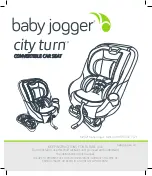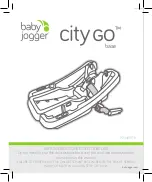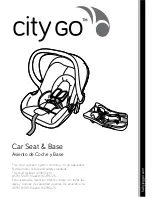
7
6
Air Bag Warning
DO NOT
use this child restraint in the front seat of a
vehicle equipped with an air bag, unless the air bag
has been deactivated. Interaction between a
rear-facing restraint and air bags may cause serious
injury or death. Air bags may cause serious injury or
death to children 12 years of age and under. If your
vehicle has an air bag, refer to your vehicle owner’s
manual for child restraint installation.
• If the rear seat of your vehicle is equipped with side
air bags, refer to the following information for proper
usage:
Vehicles built prior to the 2002 model year:
DO NOT
use this restraint in a vehicle seating position
equipped with a side air bag unless authorized by the
vehicle manufacturer.
Model year 2002 and newer vehicles:
Refer to your vehicle owner’s manual before placing
this restraint in a seating position equipped with a side
air bag.
•
DO NOT
place any objects between the restraint and
the side air bag, as an expanding air bag may cause
the items to strike your child.
The forward facing back seat is the
safest place for children 12 and under.
General Warnings
Rear-facing and Forward-facing Use
• Failure to follow the Child Requirements for
rear-facing and forward-facing use of this child
restraint could result in serious injury or death.
(See page 4 for Child Requirements).
• Failure to follow installation instructions can result in
the child striking the vehicle’s interior during a sudden
stop or crash. Serious injury or death may result.
These instructions and the instructions in your vehicle
owner’s manual must be followed carefully. If there is a
conflict between the two, the vehicle owner’s manual
regarding child restraint installation must be followed.
•
NEVER
leave child unattended.
• Children have
STRANGLED
in loose or partially
buckled harness straps. Fully restrain the child.
•
DO NOT
use child restraint if it is damaged, broken,
or missing parts.
•
DO NOT
use this restraint if it has been involved in a
crash. It must be replaced.
•
DO NOT
remove back cover.
Location Warnings
Rear-facing and Forward-facing Use
•
ALWAYS
read and follow exactly the instructions that
accompany your vehicle and child restraint.
• According to statistics, children are safer when
properly restrained in a rear seating position than in
the front seating position. Generally, the center rear
position is safest and should be used if available.
• Some child restraints do not fit all vehicles or all seating
locations. There are many thousands of combinations
of vehicle makes, models, child restraint configurations,
vehicle seat belt designs, and seat cushion shapes. The
easiest way to determine whether your child restraint is
suitable for a particular seating position is to check
WARNING
Children have STRANGLED
in loose or partially buckled
harness straps. Fully restrain
the child.
Important
WARNING
WARNING





































